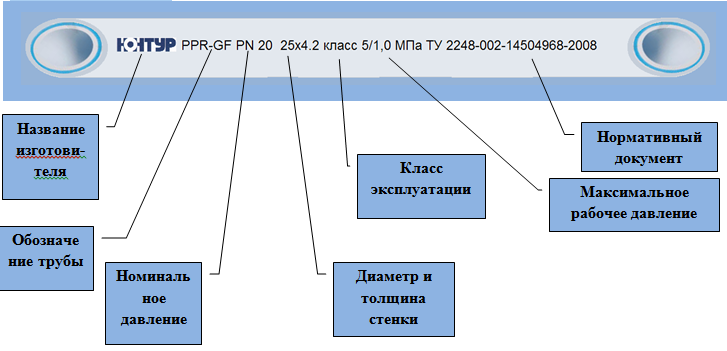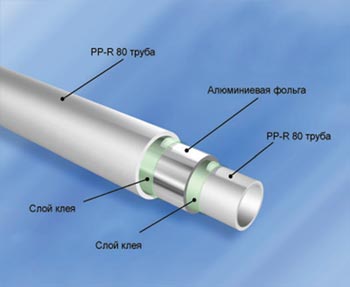Polypropylene pipes for heating - modern, reliable, durable
Polypropylene pipes are a modern element of your heating system. Thanks to the quality of the material from which polypropylene pipes are made, you will significantly increase the efficiency of your heating system. And plus, the service life of the heating system will be much longer.
The thing is that metal pipes tend to form accumulations of salts, rust and other foreign materials on their inner walls, which, as you yourself understand, make it much more difficult for the coolant to pass through the pipes.
All these factors contribute to a decrease in the quality of heating, which, in this case, will no longer meet the stated standards.
To avoid all of the above problems, experts recommend using polypropylene pipes for heating your home.
Every modern tenant who values his time and money would do well to know the most important advantages of using polypropylene pipes in a heating system:
- Financial availability of this material.
- Low thermal conductivity, which reduces heat loss.
- The service life is much higher than that of metal pipes.
How to choose the “right” pipes: marking nuances?

Painted marking
When choosing polypropylene pipes for heating, it is very important to pay attention to the markings that indicate all pipes.
For example, if you look at the pipe and see the marking PN-10, then this pipe option is not suitable for heating, since they can only be used to supply cold water with a maximum pressure of 10 atmospheres.
But you can look for a pipe marked PN-16, such pipes can withstand a water temperature of 80 ° C and a pressure of 16 atmospheres. The thickness of such a pipe is 3 mm. That is, for the installation of the heating system, you can safely use polypropylene pipes with a thickness of 3 mm or more.
Pipes that consist of only one polypropylene are called single-layer.
There are improved versions of polypropylene pipes, which are called multilayer (reinforced).
For high-quality installation of a heating system, experts recommend using reinforced polypropylene pipes for heating, which also happen:
- Three-layer - the middle layer of such a pipe is aluminum or fiberglass.
- Five-layer - in addition to polypropylene, they have a middle layer and two layers of heat-resistant glue.
Thanks to this configuration, reinforced options are very resistant to high water pressure and unstable temperature conditions.
This type of pipes appeared on our building materials market relatively recently, but has already managed to win the trust of knowledgeable specialists and users. If you decide to use thin-walled unreinforced pipes for the heating system, this can lead to unpleasant consequences - if the temperature is too high, the products can be significantly deformed.
In order to show how beneficial the use of modern materials is when installing a heating system, let's look at the main characteristics of polypropylene pipes for heating:
- Trouble-free transport due to low weight.
- Very easy installation process.
- Does not require staining.
- Ease of maintenance.
- Environmental Safety.
- Chemical and mechanical resistance.
- Flammable material.
- Ability to withstand temperatures up to 100°C.

This pipe is shown in section.
To list all the positive aspects of the operation of polypropylene pipes, you will probably need not a single page on our website. After all, this material so successfully combines quality, price, versatility and a very long service life.
Before you buy polypropylene pipes for heating, you need to decide which ones you need.
Indeed, as previously mentioned in this article, not all options can withstand the increase in coolant temperature and the powerful pressure that is created when water moves through the heating system.
Therefore, in order for your heating system to work for a long time and without fail, you must use pipes with a wall thickness of at least 3 mm. In order not to get lost in the vast world of plumbing, choose according to the marking of polypropylene pipes for heating.
These pipes have a certain marking: PN 20, which are reinforced with fiberglass, and PN 25, they have aluminum fittings.
The use of aluminum reinforced pipes will allow you to make the heating system even more reliable and durable, because thanks to the durable fitting option, the pipes can easily withstand both the maximum temperature rise and any water pressure that is created inside the heating system.
Nuances and rules for installing the system
Now let's discuss in detail how to properly install the heating system using polypropylene pipes. First you need to draw up a heating system project, based on which all pipes, fittings, taps, adapters and other additional fittings will be purchased. Do not forget to include a boiler and radiators in the future heating project.
Boilers are also different. Its choice depends on the type of fuel that you will use for heating. The boiler must be installed in a separate room with good ventilation. The boiler level must be at the level with the lowest point of the heating system or below the set point.
When buying pipes, you will be slightly surprised by the breadth of the range that the construction market can offer today. You can purchase metal, metal-plastic and polypropylene pipes.
Pipes made of metal have a rather high price, are easily susceptible to corrosion and other contamination. In addition, you will have to fool your head in order to make a high-quality installation of the heating system.
Metal-plastic pipes are relatively inexpensive and easy to install. But they have one big minus - this is the low quality of the material. Therefore, as practice shows, .
Polypropylene pipes ideally combine price, quality, durable and environmentally friendly material.
Pipes must run around the perimeter of the entire house. Your faithful assistants during installation work will be special couplings, angles, adapters for pipes of different diameters and different angles of rotation.
All these details need to be displayed in your project so that you can immediately see where which part should be. Also, the plan should show the places where it is planned to install a radiator with the indicated dimensions of the radiator itself. Do not forget to use fasteners to securely fix the pipe in a certain position.
Now you can proceed to the direct installation work. For this process, you will need a special soldering iron that easily connects two pieces of pipe in a matter of minutes.
Before starting work, cut the pipes into pieces of the required length. To do this, it is advisable to use special scissors that make the cut beautiful and even, without defects and notches. Yes, and working with such scissors is a real pleasure!
In the absence of such a tool, you can use a hacksaw, but it will not give such even cuts as you would like.
The soldering process will not give you much trouble. It is necessary to install two nozzles of the required diameter on the soldering iron, into which the pipe and fitting are inserted, and for several seconds they are heated at a temperature of 260 ° C, then the pipe and fitting are removed from the nozzles, quickly connected and held for 5-7 seconds.
When cooling, the parts form a reliable and tight connection. It is very important that the pipes are dry and clean, otherwise you will not be able to achieve 100% tightness.
If you are installing pipes that are reinforced with aluminum, then it is very important to clean up by removing the foil at a distance of 10-15 mm from the edge of the pipe. To do this, use a special knife.
During soldering, make sure that the pipes do not overheat, otherwise it may form adhesions inside the pipe, which will impede the flow of water.
After the end of the pipe, it is very important to blow it out, if the air passes without obstacles, then you have done a great job and as a reward for this you will receive hot batteries even on the most frosty days.
We definitely recommend that you also look at professional advice on where such pipes are best used. The video discusses reinforced and non-reinforced options. You will be able to better understand which products are right for you.
That's all. We hope that the material of the article was useful to you, and you can easily select the necessary products, carry out their installation.
We also invite you to join our VK group. It's very interesting and useful.
Have a nice day!
